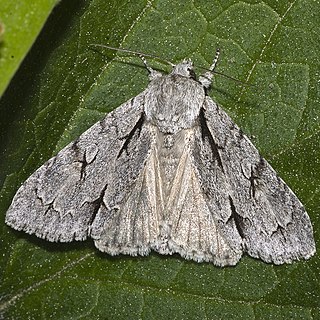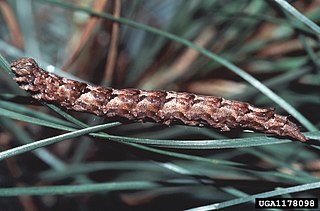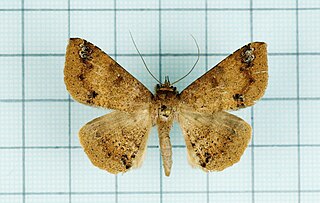
Acronicta is a genus of noctuid moths containing about 150 species distributed mainly in the temperate Holarctic, with some in adjacent subtropical regions. Caterpillars of most Acronicta species are unmistakable, with brightly colored hairy spikes, and often feed quite visibly on common foliate trees. The larva of the smeared dagger moth is unusually hairy even for this genus. Acronicta species are generally known as dagger moths, as most have one or more black dagger-shaped markings on their forewing uppersides. But some species have a conspicuous dark ring marking instead.

Delgamma is a monotypic moth genus of the family Noctuidae erected by Frederic Moore in 1885. Its only species, Delgamma pangonia, the strawberry cutworm, was first described by Achille Guenée in 1852.
Fagitana is a genus of moths of the family Noctuidae.

Eumacaria is a monotypic moth genus in the family Geometridae described by Packard in 1873. Its only species, Eumacaria madopata, the brown-bordered geometer moth, was first described by Achille Guenée in 1857. It is found in North America, where it has been recorded from British Columbia, northern Washington, southern Saskatchewan, from Maine to Florida, South Dakota, North Dakota, Nebraska, Wyoming, Idaho, Colorado and New Mexico. The habitat consists of orchards and shrublands. The species is listed as threatened in Connecticut.

Acronicta fragilis is a moth of the family Noctuidae. It is found from Newfoundland to Florida, west across Canada, south to Kentucky and Minnesota. It is listed as a species of special concern in the US state of Connecticut.

Zale submediana, the gray spring zale, is a moth of the family Noctuidae. The species was first described by Strand in 1917. It is found in the US from Wisconsin to Maine, south to New Jersey and in mountains to North Carolina.

Ericeia inangulata, the sober tabby, is a moth in the family Erebidae. The species was first described by Achille Guenée in 1852. It is found in the Indo-Australian tropics of China, India, Sri Lanka, Myanmar, and the Marianas and Carolines, Fiji, Vanuatu, New Caledonia and Samoa.

Elaphria agrotina is a moth of the family Noctuidae first described by Achille Guenée in 1852. It is found from North America, through Central America, the Antilles and Cuba to Brazil and Argentina.
Melipotis januaris, the January melipotis moth, is a species of moth in the family Erebidae. It was first described by Achille Guenée in 1852. The species has a wide range in the New World and has been recorded from St. Kitts, Montserrat, Dominica, St. Lucia, St. Vincent, Grenada, the Greater Antilles, Florida and from Mexico to Paraguay.
Nagia linteola is a species of moth in the family Erebidae first described by Achille Guenée in 1852. This species occurs in South Africa, the Democratic Republic of the Congo, Yemen, the Comoros, Mauritius, Madagascar, Indonesia (Borneo), India, Sri Lanka, Myanmar, Thailand and in Australia, where it has been recorded from Western Australia, the Northern Territory, Queensland and Victoria.

Euthyatira pudens, the dogwood thyatirid moth or peach-blossom moth, is a moth of the family Drepanidae. The species was first described by Achille Guenée in 1852. It is found in North America, where it ranges across southern Canada, south to the Gulf of Mexico. The habitat consists of moist forests and riparian zones along creeks at low to middle elevations.
Papaipema marginidens, the brick-red borer moth, is a species of moth found in North America. It was first described by Achille Guenée in 1852. It is found in eastern North America, from Pennsylvania and New York south to Georgia and North Carolina. It is now listed as endangered in the US state of Connecticut. The habitat consists of a mixture of open oak woodlands and barrens in rocky areas with herbaceous undergrowth- especially along streams.
Hydraecia immanis, the hop vine borer moth is a moth in the Noctuidae family native to North America. The species was described by Achille Guenée in 1852. It is listed as a species of special concern and is believed to be extirpated from the US state of Connecticut.
Papaipema maritima, the maritime sunflower borer moth, is a species of moth found in North America. The species was first described by Henry Bird in 1909. The larvae bore into the stems of Helianthus giganteus, forming a stem gall. It is listed as a species of special concern and believed extirpated in the US state of Connecticut.
Sideridis maryx the maroonwing moth, is a species of moth native to North America. In the US state of Connecticut, it is listed as a species of special concern and is believed to be extirpated. The larval food plant is unknown, but it is suspected to be a specialist feeding on Arctostaphylos uva-ursi. The species was first described by Achille Guenée in 1852.
Apamea lintneri, the sand wainscot moth, is a species of moth native to North America. It is listed as a species of special concern in the US state of Connecticut. The species was described by Augustus Radcliffe Grote in 1873.
Euxoa violaris, the violet dart moth, is a species of moth native to North America. It is listed as a species of special concern in the US state of Connecticut. It was described by Augustus Radcliffe Grote and Coleman Townsend Robinson in 1868.
Lithophane viridipallens, the pale green pinion moth, is a moth of the Noctuidae family that is native to North America. It is listed as a species of special concern in the US state of Connecticut. It was described by Augustus Radcliffe Grote in 1877.
Sympistis perscripta, the scribbled sallow moth is a moth of the Noctuidae family that is native to North America. It is listed as a species of special concern in the US states of Connecticut and Massachusetts. It was described by Achille Guenée in 1852. The larval hosts are Antirrhinum, Linaria, and Nuttallanthus.











